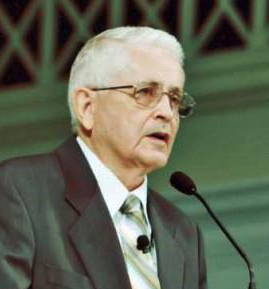Lesson 6: The Covenantal Horizon
Of Oak Trees and Detective Novels
It is especially important to remember the covenantal horizon when reading the Old Testament.
We do not start at Genesis 1 and work our way forward until we discover where it is all leading. Rather we first come to Christ, and he directs us to study the Old Testament in the light of the gospel. The gospel will interpret the Old Testament by showing us its goal and meaning.
—Graeme Goldsworthy, According to Plan: The Unfolding Revelation of God in the Bible, 55, quoted in David Murray, Jesus on Every Page: 10 Simple Ways to Seek and Find Christ in the Old Testament, 15, Kindle ed., all emphasis
mine.

[B]iblical theology ... reads not only the NT, but also the OT, as a book about Jesus.
—Brian S. Rosner, “Biblical Theology,” in New Dictionary of Biblical Theology, ed. T. Desmond Alexander and Brian S.
Rosner, electronic ed., 10, emphasis mine.

I don’t want to defend this thesis here,¹ but rather to share two illustrations that will help you better understand the relationship between the Old and New Testaments and how they both point to Jesus Christ.
The Bible Is an Oak Tree

Jason DeRouchie, whom I’ve quoted several times already, uses the picture of an oak tree to portray the relationship between the two testaments. He sees...
...a progressive development between the Old and New Testaments. The move from Old to New is a shift neither from apple seed to oak tree nor from oak tree to oak tree but from acorn to oak tree. There is an organic connection between what the OT human authors intended and what the NT human authors saw fulfilled in the person of Jesus, but the OT meaning is now often fuller, expanded, or deepened because through Christ God reveals the mystery. Often the OT prophets fully grasped both the shadow and substance of their writings (e.g., John 8:56; Dan 10:1; Acts 2:30–31), but at times we can assume their awareness was like one who plants an acorn that he knows will grow into a mighty oak, but who has little grasp of how glorious that oak would indeed be that you and I now visualize. In still other instances, though probably not too often, the OT authors may not have even recognized that the person, event, or thing that they were recounting actually foreshadowed something greater.
—Jason DeRouchie, The Mystery Revealed: A Biblical Case for Christ-Centered Old Testament Interpretation, all
emphasis mine.

And because the New Testament is the full development of what was already present in the Old Testament, you cannot fully understand what is taught in the Old Testament unless you consciously read it in light of its fulfillment in the New Testament in Jesus Christ (Luke 24:44–45; 1 Cor 15:3–4; 2 Cor 3:14; Gal 3:15–16). Bryan Chappell explains:
You do not explain what an acorn is, even if you say many true things about it (e.g., it is brown, has a cap, is found on the ground, is gathered by squirrels), if you do not in some way relate it to an oak tree. In a similar sense, preachers cannot properly explain a seed (or portion) of biblical revelation, even if they say many true things about it, unless they relate it to the redeeming work of God that all Scripture ultimately purposes to disclose.
—Bryan Chappell, Christ-Centered Preaching: Redeeming the Expository Sermon, 276, quoted in David Murray,
Jesus on Every Page: 10 Simple Ways to Seek and Find Christ in the Old Testament, 59-60, all emphasis mine.

So the acorn of the OT grew naturally and organically into the oak tree of the NT. Therefore, we must consciously read the OT in light of its fulfillment in the NT.
The Bible Is a Detective Novel

The Christian historian David Steinmetz loved mystery novels, and he explained this comparison in a chapter of a book titled “Miss Marple Reads the Bible.”
The mystery story in its classical form is often an enormous puzzle that is put together slowly, bit by bit, until at the end all of the small parts fall together into an intelligent pattern.
This kind of mystery story has two narratives. The first is a sprawling ramshackle narrative that does not seem to be leading anyplace in particular. It is filled with clues, false leads, imaginative hypotheses, and characters who frequently seem overmatched by what appear to be quite ordinary criminal minds. … The principal characters, like the readers of the story (of whom they are oblivious), are often in deep puzzlement. Of course, one must concede that Sherlock Holmes at his most baffled is never as confused as Doctor Watson.
There is a second narrative, invariably recited by the principal investigator in the last or nearly last chapter. This narrative is crisp and clear and explains in considerable detail what was really occurring while the larger narrative was unfolding. …
It is important to understand that this second narrative is not a subplot, even though it is short. It is the disclosure of the architectonic structure of the whole story. Therefore the second narrative quickly overpowers the first in the mind of the reader, who can no longer read the story as though ignorant of its plot and form. The second narrative is identical in substance to the first and therefore replaces it, not as an extraneous addition superimposed on the story or read back into it, but as a compelling and persuasive disclosure of what the story was about all along. …
The effect of all this on the reader is, of course, enormous. Casual conversations between characters that seemed at the time to be of no very great significance now appear to be charged with unmistakable importance. How, the reader wonders, could I have overlooked the Irish wool cap in the closet, the old newspapers on the front steps, the half-smoked cigar in the ashtray, or the chipped vase on the side table? ... What appeared on first reading to have been an almost random succession of events now proves to have been nothing of the kind. If one reads the last chapter first, one discovers a complex and intelligible narrative guided unerringly to its destined end by the secret hand of its author.
—David C. Steinmetz, Taking the Long View: Christian Theology in Historical Perspective, 16–17, all emphasis mine.

Therefore, Steinmetz concludes, “reading backward is not only a preferred reading strategy; it is the only sensible course of action for a reasonable person.”²
So the Bible is like a detective novel in that it contains two narratives, the OT and NT, the latter of which reveals the mystery and the structure of the former. Therefore, even though reading the entire Book from start to finish includes the joy of discovery, we must read the Bible backwards to fully understand it.
Explain in your own words why reading backwards is the best way to read the Bible.
Log in / create an account to enroll or continue where you left off.
Jesus interpreted the Scriptures using this “second narrative” principle. That reveals that reading the Bible this way isn’t a useful idea that some scholars had, but the way the Bible itself demands to be read!³ Look at how he taught the two men on the road to Emmaus after his resurrection:
And he said to them, “O foolish ones, and slow of heart to believe all that the prophets have spoken! Was it not necessary that the Christ should suffer these things and enter into his glory?” And beginning with Moses and all the Prophets, he interpreted to them in all the Scriptures the things concerning himself. —Luke 24:25–27
David Murray comments,
Jesus titled His Emmaus road sermon “The Things Concerning Himself.” He took a big text—Moses, all the Prophets, and all the Scriptures. And it had two main points—His sufferings and His glory. In other words, the whole Old Testament was about Him, specifically His sufferings and His glory. I went back and started reading the Gospels again and discovered that this note didn’t just emerge at the end of Jesus’ ministry. Right from the start He presented Himself not as a complete contrast to the Old Testament but as its climax and fulfillment.
—David Murray, Jesus on Every Page: 10 Simple Ways to Seek and Find Christ in the Old Testament, Kindle ed., 15, all emphasis mine.

Do you want to enrich your study of Scripture, to have your heart moved to worship Jesus Christ in your reading of the Old Testament? Then you need to read the Old Testament from the view of the New, seeing the acorn in light of the oak tree it would become. You need to remember the revealing second narrative in the New Testament when reading the mysterious first narrative in the Old.